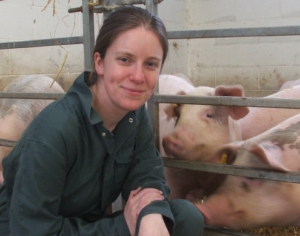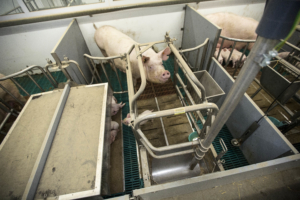Dr. Emma Baxter research scientist Scotland’s Rural College (SRUC)
This is a paper presented at a recent UK conference looking forward at prospects/trends for the UK pig industry over the next five years.
Welfare and pig production are inextricably intertwined and many organisations and individuals would like to see farrowing crates banned as they consider restraining a sow or gilt at farrowing as being unacceptable re the sow’s welfare. The opposite view is that sows are clumsy at farrowing and overlay their piglets and that these compromises the piglets’ welfare – and even its life. In the UK outdoor production accounts for 40 per cent of our output and over the last 10 years pre-weaning mortality has ranged from 12-14 per cent (AHDBPork Yearbook data), which is not much higher than many indoor units farrowing sows and gilts in crates. Switzerland, Sweden and Norway have all banned farrowing crates with Austria phasing crates out by 2033. Denmark plans on having 10 per cent free farrowing (crate less) accommodation by 2021.
In the UK Freedom Foods in the past allowed ‘temporary crating’. This term refers to farrowing pens which have  farrowing rails which restrains the sow for up to five days post farrowing after which they are removed so that the sow is free to roam around in the pen. However RSPCA Assured brought out new rules in 2016 which increased the pen area to 5.7 m sq. and also requires a bedded nest area as well as a creep, plus stating that “equipment that has the potential to confine the sow for farrowing must not be used” (RSPCA Welfare Standards for Pigs 2016).
farrowing rails which restrains the sow for up to five days post farrowing after which they are removed so that the sow is free to roam around in the pen. However RSPCA Assured brought out new rules in 2016 which increased the pen area to 5.7 m sq. and also requires a bedded nest area as well as a creep, plus stating that “equipment that has the potential to confine the sow for farrowing must not be used” (RSPCA Welfare Standards for Pigs 2016).
There are several schemes which do pay a premium for pigs produced in units with free farrowing and this of course is vital given the bigger pen footprint and cost of these pens over and above conventional crated farrowing pens. One bonus point to be thrown in the mix is the heavier weaning weights achieved with free farrowing, as piglets suckle more easily.
 In Germany there is the Aktion Tierwohl scheme whilst the Danish Co-op supermarket chain pays a premium for pigs from free farrowing systems. Recently the “Hearts for Pigs” welfare scheme was launched in Denmark. This operates at three levels with basic welfare attracting a “One heart” label and “Three hearts” having the strictest requirements. One heart accepts temporary confinement of piglets until four days, whilst to meet two hearts status temporary confinement is allowed just until two days of age. Three hearts is effectively fully outdoor production – pregnancy, farrowing through to outdoor finishing to slaughter. Currently very few Danish pigs are kept outdoors, given the harsh winter climate (by Danish standards) and it will be very interesting to see if this new scheme increases outdoor numbers. Also currently in Denmark there are around 4000 sows in zero confinement along with 8000 in temporary crated penning.
In Germany there is the Aktion Tierwohl scheme whilst the Danish Co-op supermarket chain pays a premium for pigs from free farrowing systems. Recently the “Hearts for Pigs” welfare scheme was launched in Denmark. This operates at three levels with basic welfare attracting a “One heart” label and “Three hearts” having the strictest requirements. One heart accepts temporary confinement of piglets until four days, whilst to meet two hearts status temporary confinement is allowed just until two days of age. Three hearts is effectively fully outdoor production – pregnancy, farrowing through to outdoor finishing to slaughter. Currently very few Danish pigs are kept outdoors, given the harsh winter climate (by Danish standards) and it will be very interesting to see if this new scheme increases outdoor numbers. Also currently in Denmark there are around 4000 sows in zero confinement along with 8000 in temporary crated penning.
Anyone who has been to the big trade fairs recently EuroTier/Agromek can’t help to have noticed the move by equipment manufacturers to offering larger farrowing pens with temporary crating. These pens are flexible in that they can be converted by removing some metalwork into a totally free farrowing pen. “Although they would not have the specific design features that promote good maternal behaviour that, for example, the Pig SAFE (Piglet & Sow Alternative Farrowing Environment) free farrowing pen developed by SRUC and Newcastle University has,” suggested Dr. Emma Baxter. To get some idea of how these different systems compare the Danes have recently built a fit-for-purpose “Showroom” 36m long by 18m wide which has 10 different company farrowing pens under one roof, for comparison. Nine are temporary crating pens and one is a Danish designed completely free farrowing pen (Well-Fair-Pen). Seven of the companies are Danish plus one Dutch, one Austrian and one from the UK – the Midland Pig 360 farrower. It will certainly be very interesting to see the data that these systems eventually generate.
Jetwash International based in Ireland and now also in England, has two temporary confinement systems on the market. However, these are not being tested in the Danish showroom but are being tested at Dunbia’s Pig Innovation Centre, just outside Belfast, N. Ireland.
Free farrowing is also being incorporated into group, or multi-suckling systems. This involves keeping groups of five or six sows and their litters together from farrowing to weaning and was popular back in the 1970’s.
With the right stimulation sows will come on heat three weeks after farrowing. Critically the success of multi-suckling revolves round getting the sow back in pig whilst she’s still lactating. In Australia hormones are used to induce heat which is hardly ideal. The Dutch are also re visiting this concept. Piglet mortality is variable plus if a sow isn’t milking well her piglets desert her and find a better milking sow leading to very variable sow body condition at weaning. When asked about the future for free farrowing Dr. Baxter suggested, “Loose lactation, i.e. temporary crating, will increase but the cost of full free farrowing makes it more of a challenge to see any major uptake.
Connor McVeigh, Director of McDonald’s UK supply chain, told the conference that 14000 tons of RSPCA Assured pork goes to McDonald’s each year. Many retailers rely on RSPCA Assured as their major welfare brand, so if the industry can persuade McDonald’s to add additional pork products to their menu and the demand for different RSPCA Assured pork products grows in the supermarkets there may be more opportunities to secure a premium for indoor systems that meet RSPCA Assured standards for zero confinement.
In conclusion, staff have to be comfortable working with free farrowing sows (H&S implications) Empathy is essential as well. Despite these, pre-weaning mortality is still too high and hopefully over time lines can be bred with improved mothering ability leading to less overlaying along with higher piglet survivability. Reducing mortality would obviously make free farrowing considerably more commercially attractive along with attractive premiums for the slaughter pigs.
Around 300 delegates attended the conference and there was a real buzz about things. The conference was the first major one for some time in England and in the author’s opinion more are needed. Over the years there has been a decline in trade fairs and events mirrored by the drop in the UK national pig herd. Cause or effect? We now just have our biennial pig fair with that being a shared event with the poultry sector. The UK lead body has an excellent website with masses of technical information on it. However, many UK pig farmers and managers were not brought up with computers and struggle with IT. Websites are not interactive – if he or she reads a technical bulletin and doesn’t understand it what then? Most likely hit the delete button and switch to the soccer or a cookery programme. Conferences/meetings are, as opposed to websites, two-way and are interactive plus farmers always enjoy a good chat and a chance to network.
UK producers are two pigs alive/litter below their European competitors which is not good and this calls for a quality high tech conference to look in detail at increasing litter size. Financial returns are good at the moment here in the UK but when we leave the EU what then – possibly faced with cheap imports from the USA and Brazil those two pigs a litter could be the difference between staying in business – or the opposite. Fortunately all is not gloom & doom in the UK pig industry. A £7 million investment from the Government and Leeds University will enable the University which has both indoor and outdoor units to increase sow numbers from 200 to 600 and to become a world leading research centre. Currently we go abroad to get updated. Soon that trend will be reversed and England will once again entertain overseas pig specialists, as was the case back in the 1970s. •
— By Norman Crabtree




